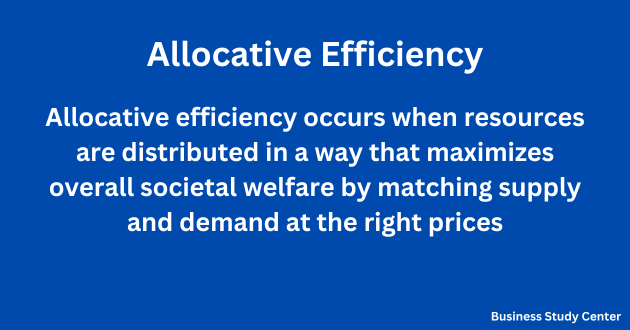
Introduction
Allocative efficiency is a concept that lies at the heart of economics and efficient resource allocation. It refers to the optimal distribution of goods and services in an economy to meet the needs and wants of society. In this comprehensive guide, we will explore the definition, importance, requirements, and examples of allocative efficiency. So, let’s dive in and unravel the intricacies of this fundamental economic concept.
Understanding Allocative Efficiency
Definition
Allocative efficiency, also known as allocational efficiency, refers to the level of output where the marginal cost of production (MC) is as close as possible to the marginal benefit (MB) derived from consuming that output. It is the state in which resources are allocated in a way that maximizes overall satisfaction in the economy, ensuring that the marginal benefit to society is equal to the marginal cost.
Importance
Allocative efficiency is crucial for the optimal utilization of limited resources in an economy. By ensuring that resources are allocated to produce goods and services that society values the most, allocative efficiency promotes economic growth and maximizes overall welfare. It helps organizations, both in the public and private sectors, make informed decisions about resource allocation, leading to profitable ventures and customer satisfaction.
Requirements for Allocational Efficiency
For allocative efficiency to occur, certain requirements must be met. These requirements ensure that the market operates efficiently and that resources are allocated optimally. Let’s explore these requirements in detail.
Informational Efficiency
An efficient market is one in which all relevant market data is readily available to all market participants. Informational efficiency ensures that no party has an informational advantage over others. It means that all necessary and pertinent information about the market, such as prices, demand, and supply, is easily accessible to all stakeholders.
Transactional Efficiency
Transactional efficiency refers to the fairness and reasonableness of transaction costs in the market. It ensures that all parties can execute transactions without any prohibitive costs. When transaction costs are reasonable and fair, capital flows to where it can be most effective, providing an optimal risk/reward scenario for investors.
How Allocative Efficiency Occurs
Allocative efficiency occurs through the interplay of market data accessibility and consumer and producer decision-making. Let’s delve into these factors in more detail.
Market Data Accessibility
Allocative efficiency relies on the accessibility of market data to all market participants. When all relevant data, such as prices, demand, and supply, is accessible, companies can make accurate decisions about which projects will be most profitable. Manufacturers can focus on producing goods and services that are in high demand, thereby meeting the needs and wants of society.
Consumer and Producer Decision-making
Consumers and producers play a crucial role in achieving allocative efficiency. Consumers’ preferences and demands drive the allocation of resources. Producers allocate resources based on consumer preferences to maximize customer benefits and profitability. By aligning production with consumer demand, allocative efficiency ensures that resources are used in a way that generates the highest value for society.
Allocative Efficiency in Practice
To better understand allocative efficiency, let’s consider an example from the clothing industry.
Example: Allocative Efficiency in the Clothing Industry
Suppose there is a clothing store that offers a variety of suit colors, including navy blue, white, yellow, and red. The majority of office staff prefer navy blue suits. In response to consumer preferences, the clothing store stocks more navy blue suits and allocates more resources towards producing and marketing them.
By focusing on the production and sale of navy blue suits, the clothing store maximizes its profits while meeting the demand of the majority of customers. Allocative efficiency is achieved when the price of the navy blue suits aligns with the marginal cost of production. This ensures that the marginal benefit derived by consumers from purchasing the navy blue suits is equal to the cost incurred by the clothing store.
Graphical Representation
Allocative efficiency can also be represented graphically. In a supply and demand diagram, allocative efficiency occurs at the equilibrium point where the supply curve intersects with the demand curve. At this point, the price of the product is equal to the marginal cost of production, ensuring an optimal allocation of resources.
Allocative Efficiency vs. Productive Efficiency
Allocative efficiency should not be confused with productive efficiency. While allocative efficiency focuses on the optimal allocation of resources to meet consumer demands, productive efficiency is concerned with producing goods and services at the lowest possible cost.
Productive efficiency ensures that resources are used efficiently in the production process, minimizing waste. It is achieved when an economy produces the maximum output possible with given resources and technology.
Both allocative efficiency and productive efficiency are important for overall economic performance. While allocative efficiency ensures that resources are allocated to meet consumer preferences, productive efficiency ensures that resources are used optimally in the production process.
Conclusion
Allocative efficiency is a fundamental concept in economics that aims to achieve the optimal distribution of goods and services to meet the needs and wants of society. By aligning resources with consumer preferences, allocative efficiency promotes economic growth and maximizes overall welfare. Accessible market data and informed decision-making by consumers and producers are key to achieving allocative efficiency.
FAQs
- How does tax affect allocative efficiency?
- Taxes, especially excise taxes, can be used to enhance resource allocation and improve allocative efficiency, especially when market imperfections exist, such as negative externalities.
- How is allocative efficiency calculated?
- Allocative efficiency is not calculated using a specific formula. It is achieved when the price of goods or services aligns with their marginal cost, ensuring that the marginal benefit to society is equal to the marginal cost.
- Can productive and allocative efficiency occur together?
- Productive efficiency and allocative efficiency are interrelated but distinct concepts. Both are important for economic performance, and achieving one does not guarantee the other. It is possible to have productive efficiency without allocative efficiency and vice versa.


